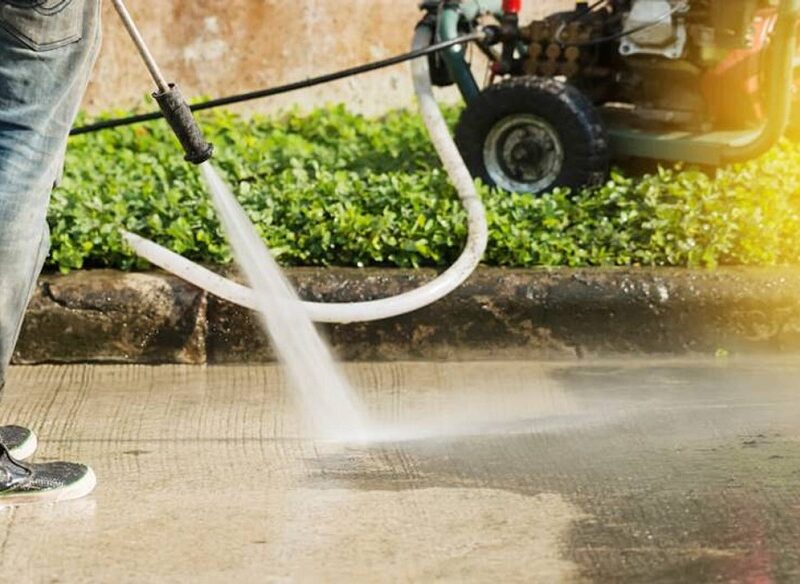Driveways, if not washed regularly, get dirty fast, especially in Australia. That’s where a pressure washer can really come in handy.
But do these power tools really do their job well, or are they overkill? And how many kids are there, and which one do you need exactly?
This guide has everything you need to know and more.
Let’s dive in and explore how you can blast away all the accumulated dirt and restore your driveway to its former glory, making your home look much more inviting.
How To Choose the Right Equipment
There are many kinds of pressure washers out there, so it’s important to understand each one before you can pick the right one for you.
For example, electric washers are nice and easy for smaller driveways. They are quieter too, which is perfect if you don’t fancy becoming the neighbourhood noise polluter.
Petrol ones, on the other hand, pack a punch and are good for larger outdoor areas. They’ll cut through tougher messes, but they’re noisier and pricier. On top of that, they demand regular refuelling and maintenance to keep running smoothly.
You’ll also want something with at least 3000 PSI to get the job done, especially if you’re working with years’ worth of stains and debris.
If you’re not willing to spend a lot of cash to own one, you can always rent one for the weekend. When you do that, pick a model with a wide nozzle. This one provides faster coverage and less time spent cleaning.
If you want to save money, make sure to check out at least several shops, as some of them tend to charge more than others.
In the end, knowing what kind of tool covers your needs is how you’re going to save cash and unnecessary effort.
Gather The Necessary Supplies
Once you’ve selected your washer, it’s time to grab a few extras that make the job safer and easier.
Protecting yourself comes first, always. Use full-coverage goggles to keep grit and spray out of your eyes. A solid pair of gloves will help you keep a steady grip if things get slippery.
Next, think about what detergent you’re adding to the machine. A good biodegradable formula will handle the job pretty well. Plus, it will not leave behind any harsh chemical residue, which could damage your concrete or harm the environment.
Some machines even require using specific solutions, so it’s worth double-checking the manual before you start. When renting the washer, ask whether detergent is included in the package—some places provide that service, which saves you an extra errand.
Prepare the Area
Before you fire up the washer, take a few minutes to clear the space. Move cars, outdoor furniture, and anything else that can get in the way (and that you’d rather keep dry).
Give the driveway a quick sweep, too—small bits of gravel or leaves can make a mess once the water hits.
If you’ve got plants close by, cover them so they don’t get damaged. It’s also smart to check the concrete for any cracks, as pressure washing can make them worse.
And while you’re at it, take a look at where the water will drain. A little prep now keeps cleanup simple and avoids unexpected puddles later.
Apply the Cleaning Solution
Now for the key part: applying the cleaning solution with purpose.
Set the washer to low-pressure mode and cover the driveway in chunks. Allow the cleaner to sit for a few minutes, but don’t let it dry out completely.
For oil spills, use a degreaser first, then the detergent. If the weather’s really hot, give the surface a light mist every so often so the cleaner doesn’t evaporate completely.
Start Washing
Now it’s time to unleash the full power of your pressure washer. Set it to maximum intensity and keep the nozzle around a foot away from the surface. Any closer, and you risk damaging the concrete.
Move the wand in slow, steady lines like you’re mowing a very stubborn lawn. Work your way backwards to avoid walking through freshly cleaned areas and slowing down your progress.
If you come across stains that seem determined to outlast your efforts, hold the nozzle over them a bit longer. Alternatively, you can switch to a narrower spray for more focused cleaning power.
If the dirt is truly relentless and you feel outmatched, there’s no shame in calling in professionals with industrial gear. However, give it a proper go first and you might be surprised at the results.
Rinse and Dry
Rinsing is what completes the job, so don’t rush to call it a day yet. Use fresh water and apply moderate pressure in systematic passes until there’s no soap residue left lurking anywhere.
Let the surface dry for at least a day before returning the furniture and cars to their previous place. If the sun is too strong, add a bit of shade over the area to avoid weird drying marks. A squeegee or broom can help you speed things along, if necessary.
Once everything is dry, take a slow walk across the driveway to spot any patches you might have missed. Sometimes grime hides in corners or near edges.
Catching those now saves you from noticing them later when everything else looks spotless. A quick touch-up here and there will give the whole surface a clean, even finish. It’s a small step, but it makes the difference between “good enough” and “a job well done.”
It’s okay if you don’t feel like getting your hands dirty. You could always consider a house maid service to handle everything instead.
Conclusion
A freshly washed driveway doesn’t just look better—it makes the whole front of your home feel and look amazing.
It’s one of those satisfying jobs where the payoff is immediate, and you can actually see the difference with every pass of the washer.
So grab a cool drink, sit outside and admire your handiwork. A clean driveway is truly something to behold and be proud of.











